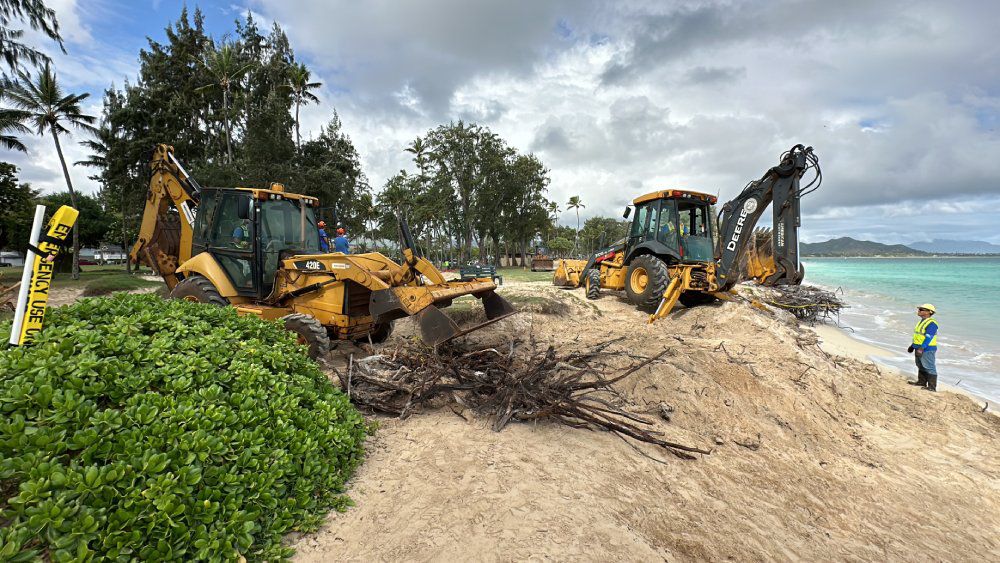The City and County of Honolulu’s Department of Parks and Recreation, State of Hawaii’s Department of Land and Natural Resources’ Office of Conservation and Coastal Lands, Hawaii Sea Grant, and “future” community groups will be coming together in phased efforts to preserve a popular section of the Kailua shoreline experiencing significant erosion.
The groups will focus their efforts on the Lanikai side of Kailua Beach Park between Kaelepulu Stream and Ocean Safety Lifeguard Tower 8B, according to a news release.
DPR crews already began work in November removing four tree stumps, two fallen trees, five trees that were leaning, and trimmed 14 trees to reduce the chances of their falling.
Early next year, crews will return to the area to push sand accumulating along park pathways and the comfort station further makai. They will also remove non-functioning park infrastructure such as undermined concrete pads and inoperable irrigation.
DPR, OCCL and Hawaii Sea Grant will then coordinate with the community on installing geotextile fencing designed to capture and retain the fine sand before planting native ground cover, trees and creating pathways to further stabilize the shoreline expected to be done later in 2025. Another “sand pushing” will be conducted before the planting.
“Beach loss here at Kailua Beach, and around the Hawaiian Islands, will continue to be an issue. A healthy coastal ecosystem with vegetated dunes can mitigate some of the impacts,” said Amy Wirts in the release. Wirts is a Sea Grant agent who works with OCCL.
“We have found that landscaping with native ground cover, such as ‘aki‘aki, pōhuehue, and nanea, and native shade trees such as kou or milo, help to build a healthy dune system. Community-led dune restoration projects at locations such as Oahu’s Sunset Beach and Kanaha Park on Maui have been very successful, and we hope to replicate that success here,” Wirts said.

In order to minimize the impact to beachgoers and recreational users, work is being done in a phased manner.
Meetings for a community working group will be scheduled to coordinate efforts among members of the public and longtime Kailua Beach users, according to DPR. Those interested in taking part in the community working group can email c.rossideleon@honolulu.gov and awirts@hawaii.edu.
“A big mahalo to all of the state and park staff, as well as our future collaborative partners, who are pulling together to help protect one of our most precious natural resources,” said Nate Serota with the Honolulu Department of Parks and Recreation.
“We want to make sure the community is both kept in the loop on this restoration effort and given the opportunity to be part of the positive change. So we can all be stewards of this magnificent coastline. Ultimately, our goal is to utilize our shared māna‘o to act strategically and preserve the beach in a functional and sustainable manner, so it can be enjoyed for future generations to come. We look forward to sharing much more with the community as we progress through this kākou effort in 2025,” Serota said.

The 2022 Hawaii Dune Restoration Manual outlines part of the dune restoration effort for Kailua Beach Park. According to DPR, although this particular stretch of shoreline and the greater Kailua Beach dune system are considered stable, erosion has narrowed the beach with observable changes over the past five years.
DPR cites the Recreational Use and Management at Kailua Beach Park report published by Hawaii Sea Grant, which states that over 1,700 people visit the park each day. The report is part of a larger Windward Oahu Tourist Assessment addressing use of shoreline and public spaces in Kailua and Waimanalo.
According to the DPR, over 70% of beaches in Hawaii and 60% of beaches on Oahu are in a state of chronic erosion with an estimated 5.5 miles of beach already lost on Oahu.
In the 2022 Sea Level Rise Guidance Update, the Honolulu Climate Change Commission suggests sea level will rise by 3.8 feet throughout the state by 2100.










